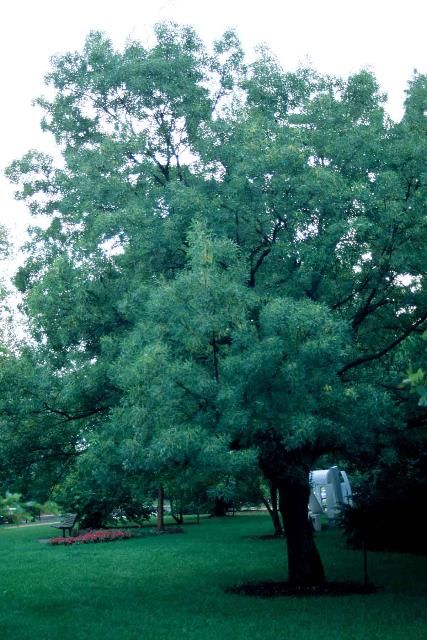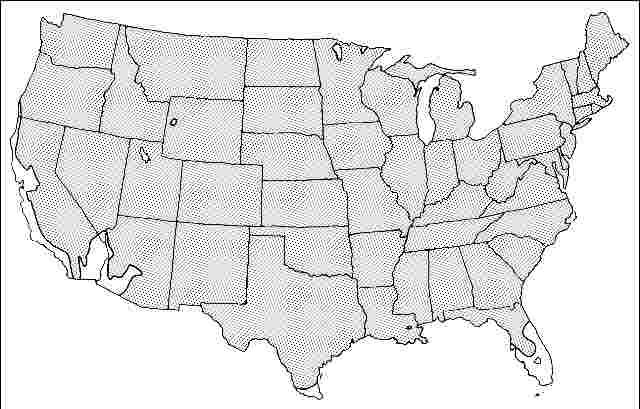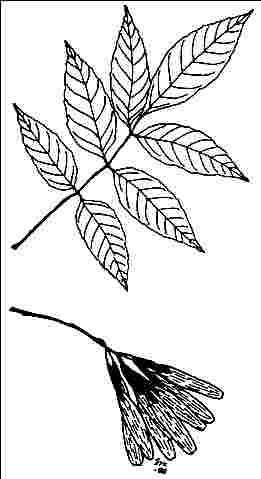Introduction
White Ash is resistant to heat, although it is native to moist locations, including river bottoms and well-drained upland sites. It grows 50 to 80 feet tall and wide. The trees produce a good seed-set every two to three years and they germinate in the landscape creating a nuisance and perhaps look a bit messy. The seeds are used by many birds and can be produced in countless numbers. The tree grows rapidly and is almost pyramidal when young, but gradually slows down and develops a more spreading round or oval shape. White Ash prefers a sunny exposure where it develops a showy yellow fall color. Fall color can be striking or dull, depending on the tree and environmental conditions.

Credit: Ed Gilman
General Information
Scientific name: Fraxinus americana
Pronunciation: FRACK-sih-nus uh-mair-ih-KAY-nuh
Common name(s): White Ash
Family: Oleaceae
USDA hardiness zones: 3A through 9A (Fig. 2)
Origin: native to North America
Invasive potential: little invasive potential
Uses: street without sidewalk; shade; tree lawn > 6 ft wide; highway median
Availability: not native to North America

Description
Height: 50 to 80 feet
Spread: 40 to 60 feet
Crown uniformity: symmetrical
Crown shape: pyramidal, round, oval
Crown density: moderate
Growth rate: fast
Texture: medium
Foliage
Leaf arrangement: opposite/subopposite (Fig. 3)
Leaf type: odd-pinnately compound
Leaf margin: entire, serrulate
Leaf shape: ovate, lanceolate
Leaf venation: pinnate
Leaf type and persistence: deciduous
Leaf blade length: 2 to 4 inches
Leaf color: green
Fall color: yellow, purple
Fall characteristic: showy

Flower
Flower color: green
Flower characteristics: not showy
Fruit
Fruit shape: elongated
Fruit length: 1 to 3 inches
Fruit covering: dry or hard
Fruit color: tan
Fruit characteristics: attracts birds; showy; fruit/leaves a litter problem
Trunk and Branches
Trunk/bark/branches: branches don't droop; not showy; typically one trunk; thorns
Pruning requirement: needed for strong structure
Breakage: susceptible to breakage
Current year twig color: brown, gray
Current year twig thickness: thick
Wood specific gravity: 0.60
Culture
Light requirement: partial sun or partial shade, full sun
Soil tolerances: clay; sand; loam; alkaline; acidic; extended flooding; well-drained
Drought tolerance: moderate
Aerosol salt tolerance: high
Other
Roots: can form large surface roots
Winter interest: no
Outstanding tree: no
Ozone sensitivity: tolerant
Verticillium wilt susceptibility: susceptible
Pest resistance: sensitive to pests/diseases
Use and Management
The tree is easy to transplant although it can be coarse-rooted, producing troublesome surface roots. A good tree for large open areas but much too large for home landscapes unless you want lots of shade. The potential disease and insect problems limit use to parks and other areas where the tree will not be missed if it dies. Extensive use as a street tree in some areas could be risky because of potential insect and disease problems, especially borers, and a sensitivity to drought. Ash decline is one of its major problems and is probably caused by a complex of conditions, including a mycoplasma-like organism.
White Ash which have not been properly pruned can break apart in wind storms, but it has better branch structure than seedling Green Ash. Be sure to space branches along the trunk and remove those which are vigorously growing upright with narrow branch crotches. Ash is prone to develop double and multiple leaders (trunks) which must be removed for proper tree development. Major branches often develop opposite each other, and one should be removed to develop good structure.
Ash does not tolerate soil compaction or construction injury due to an extensive root system. It appreciates good soil and is probably not a good choice for poor, urban soils. It is not tolerant of heavy clay.
The following cultivars were selected for being seedless and for the better purplish fall color: `Autumn Applause'; `Autumn Purple'. `Rosehill' has better branch arrangement. Fraxinus texensis may be the best Ash of Texas but it is largely untested in urban areas. Fraxinus velutina has been widely planted in the Dallas area and performs well, but has weak branch crotches.
Pests
Borers are common on Ash and they can kill trees. The most common borers infesting Ash are Ash borer, lilac borer and carpenterworm. Ash borer bores into the trunk at or near the soil line causing tree dieback. Lilac borer causes swellings on the trunk and limbs where the insect enters the tree. The carpenterworm larvae bore into the heartwood but come to the outside of the tree to push out frass and sawdust. Heavily infested trees can be severely weakened. Keep trees as healthy as possible by fertilizing regularly and watering during dry weather.
Aphids are often seen but are usually not serious.
In late summer, fall webworm covers branches with webbing. The nests in branches close to the ground can be pruned out when first noticed. Bacillus thuringiensis may control fall webworm.
The Ash flower-gall looks like a disease but is actually a mite problem. The mites feed on the flowers causing abnormal growth. The galls dry out and persist on the tree into winter.
Diseases
A rust disease causes distorted leaves and swollen twigs. Small, yellow, cup-like structures, producing yellow spores, appear on the infected areas. Controls are usually not needed.
A number of fungi cause leaf spots on Ash. The disease is worse in wet years and is partially controlled by gathering and disposing of diseased, fallen leaves.
Anthracnose is also called leaf scorch and leaf spot. Infected parts of the leaves turn brown, especially along the margins. Infected leaves fall prematurely. Rake up and destroy infected leaves. Chemical controls are not practical or economical on most large trees.
Canker diseases cause branch dieback and death of the tree when the trunk is infected. Try to keep trees healthy with regular fertilization.
Powdery mildew makes a white coating on the leaves.
Ash ring spot virus causes chlorotic red and yellowish spots or rings on the leaves. Infected trees may be stunted and dieback, but often the problem in minor.
Verticillium wilt causes branches of infected trees to wilt and die, eventually the entire tree may die. Keep trees healthy and fertilize infected trees to suppress disease symptoms.